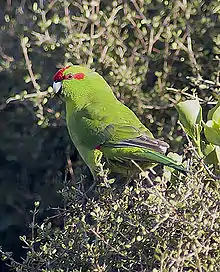Cyanoramphus
Cyanoramphus is a genus of parakeets native to New Zealand and islands of the southern Pacific Ocean. The New Zealand forms are often referred to as kākāriki. They are small to medium-sized parakeets with long tails and predominately green plumage. Most species are forest species, although several of the subantarctic species live in open grassland. The genus formerly had a disjunct distribution, with two species found in the Society Islands and the majority of the genus ranging from New Caledonia to Macquarie Island, but absent from the 4,100 km (2,500 mi) in between. Despite many fossil birds being found in the islands between these two areas being found none of these were of undescribed Cyanoramphus species.[1]
| Cyanoramphus | |
|---|---|
 | |
| Red-crowned parakeet (Cyanoramphus novaezelandiae) | |
| Scientific classification | |
| Kingdom: | Animalia |
| Phylum: | Chordata |
| Class: | Aves |
| Order: | Psittaciformes |
| Family: | Psittaculidae |
| Tribe: | Platycercini |
| Genus: | Cyanoramphus Bonaparte, 1854 |
| Species | |
|
Cyanoramphus auriceps | |
Like many other species of birds the Cyanoramphus parakeets have suffered from changes brought about by humans. The two species from the Society Islands, the black-fronted parakeet and the Society parakeet, have become extinct as have the subspecies from Lord Howe Island and Macquarie Island, as well as an undescribed form from Campbell Island. One species, the Malherbe's parakeet (C. malherbi), is critically endangered while most other species are endangered or vulnerable. Habitat loss and introduced species are considered responsible for the declines and extinctions.[2]
The genus Cyanoramphus was introduced in 1854 by the French ornithologist Charles Lucien Bonaparte.[3] The genus name combines the Ancient Greek kuanos meaning "dark-blue" and rhamphos meaning "bill".[4] The type species was designated by English zoologist George Robert Gray in 1855 as what is now the extinct black-fronted parakeet (Cyanoramphus zealandicus).[5][6]
Species
| |||||||||||||||||||||||||||||||||||||||||||||||||||
| Phylogeny of Cyanoramphus |
There are 12 recognised species, of which 4 are extinct:[7]
- † Black-fronted parakeet (C. zealandicus)
- † Raiatea parakeet (C. ulietanus)
- New Caledonian parakeet (C. saisseti)
- Chatham parakeet (C. forbesi) formerly considered a subspecies of C. auriceps[8][9]
- Norfolk parakeet (C. cooki)
- † Lord Howe parakeet (C. subflavescens)
- Antipodes parakeet (C. unicolor)
- Yellow-crowned parakeet (C. auriceps)
- Malherbe's parakeet (C. malherbi) formerly considered a subspecies of C. auriceps[8][9]
- Red-crowned parakeet (C. novaezelandiae)
- Reischek's parakeet (C. hochstetteri) formerly considered a subspecies of C. novaezelandiae[9][10]
- † Macquarie parakeet (C. erythrotis)[11]
The two forms of C. erythrotis are usually considered to be distinct species: the single specimen believed to be from Macquarie Island (Canterbury Museum specimen AV2099, O'Connor catalog 369) in Boon et al.'s analysis has turned out to be from the Antipodes Islands population (hochstetteri) instead.[12] In addition there are subfossil remains from a yet undescribed extinct Cyanoramphus species from Campbell Island.[13]
References
- Steadman, D. (2006). Extinction and Biogeography in Tropical Pacific Birds. University of Chicago Press. ISBN 978-0-226-77142-7.
- Taylor, R. (1979). "How the Macquarie Island Parakeet became extinct" (PDF). New Zealand Journal of Ecology. 2: 42–45.
- Bonaparte, Charles Lucien (1854). "Tableau des perroquets". Revue et Magasin de Zoologie Pure et Appliquée. 2nd series. 6: 145–158 [153].
- Jobling, James A. (2010). The Helm Dictionary of Scientific Bird Names. London: Christopher Helm. p. 128. ISBN 978-1-4081-2501-4.
- Gray, George Robert (1855). Catalogue of the Genera and Subgenera of Birds Contained in the British Museum. London: British Museum. p. 86.
- Peters, James Lee, ed. (1937). Check-list of Birds of the World. Volume 3. Cambridge, Massachusetts: Harvard University Press. p. 269.
- Gill, Frank; Donsker, David; Rasmussen, Pamela, eds. (2020). "Parrots, cockatoos". IOC World Bird List Version 10.1. International Ornithologists' Union. Retrieved 24 February 2020.
- Triggs, S.J.; Daugherty, C.H. (1996). "Conservation and genetics of New Zealand parakeets". Conservation International. 6: 89–101. doi:10.1017/S0959270900001337.
- Boon, W.M.; Kearvell, J.; Daugherty, C.H.; Chambers, G.K. (2001). "Molecular systematics and conservation of kakariki (Cyanoramphus spp.)" (PDF). Science for Conservation. 176.
- Christidis, L.; Boles, W.E. (2008). Systematics and Taxonomy of Australian Birds. Collingwood, Victoria, Australia: CSIRO Publishing. ISBN 978-064309602-8.
- Chambers, Geoffrey K.; Boon, Wee Ming (2005). "Molecular systematics of Macquarie Island and Reischek's parakeets" (PDF). Notornis. 52 (4): 249–250.
- Scofield, R. Paul (2005). "The supposed Macquarie parakeet in the collection of Canterbury Museum" (PDF). Notornis. 52 (2): 117–120.
- Holdaway, R.N.; Thorneycroft, J.M.; McClelland, P.; Bunce, M. (2010). "Former presence of a parakeet (Cyanoramphus sp.) on Campbell Island, New Zealand subantarctic, with notes on the island's fossil sites and fossil record" (PDF). Notornis. 57: 8–18.
External links
| Wikimedia Commons has media related to Cyanoramphus. |